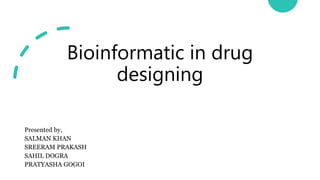
Bioinformatic in drug designing
- 1. Bioinformatic in drug designing Presented by, SALMAN KHAN SREERAM PRAKASH SAHIL DOGRA PRATYASHA GOGOI
- 2. What is bioinformatics? • The field of science in which biology, computer science, and information technology merge into a single discipline. • The ultimate goal of the field is to enable the discovery of new biological insights as well as to create a global perspective from which unifying principles in biology can be discerned. • There are three important sub- disciplines within bioinformatics: the development of new algorithms and statistics with which to assess relationships among members of large data sets; the analysis and interpretation of various types of data including nucleotide and amino acid sequences, protein domains, and protein structures; and the development and implementation of tools that enable efficient access and management of different types of information.
- 3. Drug Design • In pharmacology, Drug is any chemical agent that alters the biochemical or physiological processes of tissues or organisms • Drug design or rational drug design, is the discovery process of finding new medications based on the knowledge of a biological target. • The drug is most commonly an organic small molecule that activates or inhibits the function of a biomolecule such as a protein, which in turn results in a therapeutic benefit to the patient & it is mostly involves the design of molecules that are complementary in shape and charge to the biomolecular target with which they interact & therefore will bind to it & drug design frequently but not necessarily relies on computer modeling technique.
- 4. Developing a new drug is Lengthy, Risky It involves a number of processes Very expensive. Drug discovery development and AIM Identify disease Isolate protein involved in disease (2-5 years) Find a drug effective against disease protein (2-5 years) Preclinical testing (1-3 years) Scale-up: using animal studies, formulation; Human clinical trails(2-10 years) FDA approval (2-3 years) Drug. Aim: The diagnosis- determine the cause of disease. Cure- relieve of the symptoms of a disease. Migration –action of reducing the severity of a disease. Treatment- Medical care. Prevention of disease.
- 7. Technology is impacting this process
- 8. Application of bioinformatics in drug discovery The application of bioinformatics cut across all the process of drug discovery, thereby Reducing the risk of drug failure Making it a bit cheaper Reducing the time spent in the discovery and Also automates the entire process, thereby reducing human intervention.
- 9. High- Throughput Screening Drug companies now have millions of samples of chemical compounds. High-throughput screening can test 100,000 compounds a day for activity against a protein target. Maybe tens of thousands of these compounds will show some activity for the protein. The chemist needs to intelligently select the 2 - 3 classes of compounds that show the most promise for being drugs to follow.
- 10. Computer Aided Drug Designing • Machine Learning Methods E.g. Neural nets, Bayesian nets, SVMs, Kahonen nets. • Train with compounds of known activity ◦ • Predict activity of “unknown” compounds • Scoring methods • Profile compounds based on properties related to target • Fast Docking ◦ Rapidly “dock” 3D representations of molecules into 3D representations of proteins, and score according to how well they bind.
- 11. Gene chips “Gene chips” allow us to look for changes in protein expression for different people with a variety of conditions, and to see if the presence of drugs changes that expression . Makes possible the design of drugs to target different phenotypes compounds administered people / conditions e.g. obese, cancer, Caucasian expression profile (screen for 35,000 genes).
- 12. Molecular Modeling • 3D Visualization of interactions between compounds and proteins. • “Docking” compounds into proteins computationally .
- 13. 3-D visualization • X-ray crystallography and NMR Spectroscopy can reveal 3D structure of protein and bound compounds . • Visualization of these “complexes” of proteins and potential drugs can help scientists understand the mechanism of action of the drug and to improve the design of a drug . • Visualization uses computational “ball and stick” model of atoms and bonds, as well as surfaces . • Stereoscopic visualization is available.
- 14. In vitro& in silico ADME models Traditionally, animals were used for pre human testing. However, Animal tests are expensive, time consuming and ethically undesirable. ADME(absorption, distribution, metabolism, excretion)techniques help model how drug will likely act in body. These methods can be experimental(in vitro)using cellular tissue, or in silico, using computational models
- 15. In silico ADME models • Computational methods can predict compound properties important to ADME .e.g. Log p.a lipophilicity measure Solubility Permeability Cytochrome p450 metabolism
- 16. Structure database • MSD: The macromolecular structure database • 3Dseq:3d sequence alignment server • FSSP: based on exhaustive all against all 3d structure comparison of protein in the PDB • DALI: fold classification based on structure – structure • NDB: nucleic acid structure database
- 17. • SWISS-PROT: Annotated Sequence Database • TrEMBL: Database of EMBL nucleotide translated sequences • InterPro: Integrated resource for protein families, domains and functional sites. • SWISS-PROT, TrEMBL, Ensembl and RefSeq. • IntEnz: The Integrated relational Enzyme database (IntEnz) will contain enzyme data approved by the Nomenclature Committee Protein databases
- 18. References • Https://www.Xenotech.Com/nonclinical-studies/adme/ • Https://blogs.Siliconindia.Com/shribioinformatics/bioinformatics -in-drug-designing-bid-ch0s2jv471570920.Html • Bioinformatics approaches for new drug discovery: a review kullappan malathi et,al.2016.
